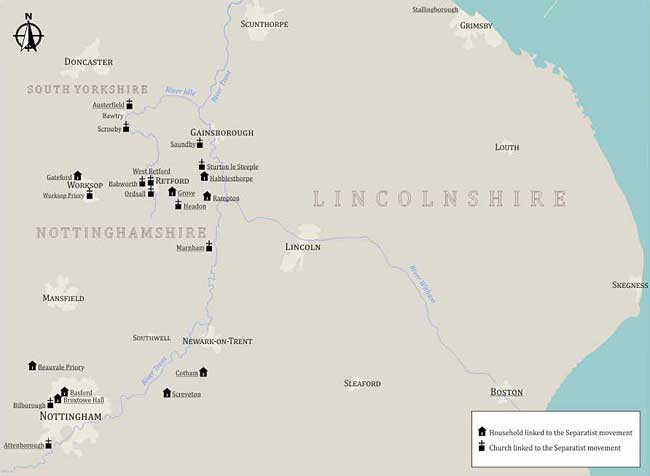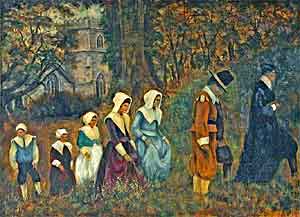
Overview
The importance of Nottinghamshire in the history of religious radicalism, leading to the voyage of the ‘Mayflower’, has been understated due to how the story has been told. From the mid-1800s onwards, the history has most often been written by Americans with a narrow focus on those who settled in New England. As a result, the separatist movement’s early growth in Nottinghamshire and its important alternative strand that gave rise to the Baptists and the doctrine of religious liberty have been underplayed.
The Separatists of the early 1600s developed out of radical puritanism in Nottinghamshire in the previous five decades or more. It resulted in congregations at Scrooby and Gainsborough that were both led by local men, and who went to the Netherlands together in 1608. This resulted in two movements of international significance: the ‘Mayflower’ settlers in New England and the first English Baptist congregations who were pioneer supporters of religious liberty.
 Map of the places mentioned in the entry. Click on the image to view a printable PDF version of the map.
Map of the places mentioned in the entry. Click on the image to view a printable PDF version of the map.The roots of the movement can be found in the early development of evangelical Protestantism amongst the Nottinghamshire gentry. Arguably this can be traced to Thomas Cranmer, the Archbishop of Canterbury, whose family connections also linked him with radical elements present in Boston from the 1520s. These included the martyr James Bainham and the Morice brothers, one of whom became his secretary.
The connection in Nottinghamshire was most probably evangelical gentry like Sir John Markham of Cotham, of whom Cranmer commented in 1536 that ‘Sir John of long season hath unfeignedly favoured the truth of God’s word.’ The position of the evangelical gentry in Nottinghamshire was enhanced by their record in supporting the Crown during the rebellions of 1536-7, and their powers and wealth increased due to their significant role in the dissolution of the monasteries. The dissolution brought major benefits to families such as the Lassells of Sturton and Gateford, the Whalleys of Screveton, and the Babingtons of Rampton and elsewhere.
Sir John Markham was related to Sir John Hercy of Grove, the leading evangelical in the north of the county in the 1530s-40s, much of whose wealth was left to the Retford family of Denman. He was also the guardian of the Lassells children; George Lassells especially acted as an agent for the dissolution but John Lassells was executed in 1546 for his advanced evangelical views.
Hercy and the Denmans, with their associates such as the Wasteneys at Headon, were able to use the Church’s patronage system to bring in clergy who followed their views. There was a slight hiatus during the time of Mary, when William Denman of Ordsall and West Retford had to leave the country and several local clergy were removed or ‘deprived’, but this approach continued in the 1560s despite the restrictions of the Elizabethan Settlement.
The radical gentry disagreed with aspects of the Settlement, especially around worship. They wanted to purify the Church of any Roman Catholic elements, and so became known as ‘puritans.’ They initially pursued their policies with little interference from the Archbishop of York who was to some degree sympathetic but also more greatly troubled by Catholics. The Archdeacon of Nottingham for much of this time was also ineffective. Thus by the 1570s a number of churches – at least thirty – were well-established puritan centres; these included Screveton, where the Whalleys controlled life, and many churches in and around Retford including West Retford and Babworth.
One of the first of the clergy to be deprived was John Swinscoe at Headon in 1567. He was immediately found another post by Thomas Babington at Marnham, then moved to Saundby - another puritan stronghold.

Pilgrims heading home from Babworth church. Painted by a prisoner at Ranby Prison in the 1960s.
A plaque in the porch of Babworth church commemorates the formation of a ‘separatist church’ there in 1586. Separatists were the branch of puritanism who felt they could no longer remain within the Church of England, but the information on the memorial is wrong. The date of 1586 is simply the year when Richard Clifton, who had been Swinscoe’s successor at Marnham, was appointed Rector of Babworth. He did not become a separatist at this point – in fact he was simply the third (at least) in a line of puritan ministers that the gentry of Babworth and Retford had introduced to this church.
Clifton’s preaching at Babworth attracted wide interest including that of William Brewster and the young William Bradford. However, it is unlikely that Brewster was at Babworth every Sunday since he controlled his own ‘chapel of ease’ at Scrooby where he appointed curates to suit his tastes. But in 1605 the leaders of the Church of England decided to try to bring the rebellious puritans under control by ‘depriving’ their most prominent leaders – Clifton, Richard Bernard of Worksop, Brewster’s curate Henry Gray, and Robert Southworth of Headon. Yet others were not deprived – Brian Barton of South Collingham surviving despite being a rebel for more than thirty years.
What happened after this is not so certain. The most likely sequence is that Clifton moved to Scrooby where was accused of ‘pretending’ to be curate and that a small congregation gathered there. Meanwhile a similar group of radical puritans was gathering at Gainsborough under John Smyth, a radical and restless clergyman who had been born in or near Sturton-le-Steeple and had been briefly city lecturer in Lincoln. Smyth’s associates included the layman Thomas Helwys of Broxtowe and also Richard Bernard, though his relationship with the latter broke down after Bernard was persuaded to rejoin the Church of England.
Smyth was perhaps the guiding force in the conference of radicals that took place at Lady Isabel Bowes’s house to discuss what they should do. At this point John Robinson, a jobless radical clergyman, also joined the group. Who said what about the decision to finally ‘separate’ and move to the Netherlands was then heavily disputed by all the participants but the stress seems to have caused a breakdown for Smyth, who went to live with Helwys at Basford before going to Amsterdam.
The story of the escape to Amsterdam is mainly well known. The arrest of the separatists at Boston in 1607 after they were betrayed revealed some interesting aspects – one was that they had clearly been in Boston for some time, and the other was the close connection between at least the Scrooby group and radicals in the Lincolnshire port.
Scores of separatists left Gainsborough in May 1608 for a rendezvous on the coast at Stallingborough, where some of them – notably Thomas Helwys – were arrested. Helwys was the main organiser and financier for the escape, having hired the boat under cover of his relative Sir Gervase Helwys of Saundby from another of the Nottinghamshire puritan gentry, Anthony Brackenbury.
Once in the Netherlands the two groups did not stay together. John Robinson replaced Clifton as the leader of the ‘Scrooby’ group, who moved to Leiden. By the late 1600s this group had multiple concerns about their security in the Netherlands and so decided to move to America, from which came the famous voyage of the ‘Mayflower’ in 1620. After the early death of John Carver, William Brewster became the leader of the group. John Smyth’s group took an even more radical direction: perhaps influenced by the Mennonites around them, Smyth rejected Calvinism and became a believer in believers’ baptism – both causing an irreparable breach with the Leiden group. Thomas Helwys followed Smyth, and then returned to establish a Baptist congregation in London in about 1611. Helwys and his associate John Murton then wrote major works proposing religious liberty for all faiths which were to prove hugely significant, ironically, in American history.
Meanwhile the radical Nottinghamshire families that remained, such as the Whalleys and the Iretons of Attenborough, became leading opponents of Charles I and Laud.